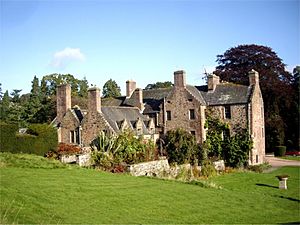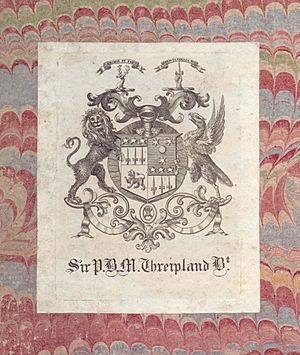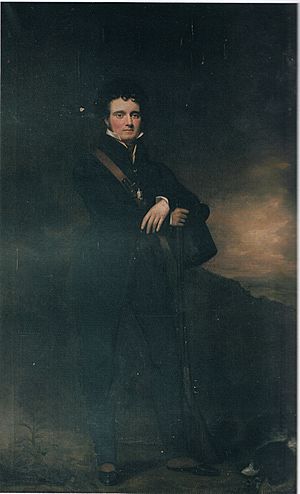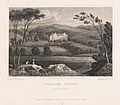Fingask Castle facts for kids
Quick facts for kids Fingask Castle |
|
|---|---|

Fingask Castle in 2008
|
|
| Location | Rait, Perthshire, Scotland |
|
Listed Building – Category B
|
|
| Lua error in Module:Location_map at line 420: attempt to index field 'wikibase' (a nil value). | |
Fingask Castle is a historic country house located in Perth and Kinross, Scotland. It sits high up, about 200 feet (61 meters) above the village of Rait. The castle is three miles (5 km) north-east of Errol. It is found in an area called the Braes of the Carse, on the edge of the Sidlaw Hills. From this spot, Fingask Castle looks out over both the Carse of Gowrie and the Firth of Tay. You can even see into the Kingdom of Fife from here! The name Fingask comes from a Gaelic phrase meaning "white" or "light-coloured appendage."
Fingask was once a special religious place. It was a convenient and important stop for travelers between the abbeys at Falkirk and Scone. Later, the Bruce family owned the castle, followed by the Threiplands. In the 1700s, the castle owners supported the Jacobites. Because of this, the castle was taken away from them by the government. Today, Fingask Castle is a Category B listed building, which means it's a protected historic site. Its gardens are also listed on the Inventory of Historic Gardens and Designed Landscapes. This is a national list of important gardens.
Contents
- Exploring Fingask Castle's History
- The Castle Building and Its Features
- Exploring the Beautiful Gardens at Fingask
- Images for kids
- See also
Exploring Fingask Castle's History
Fingask Castle has a long and interesting past. It has been mentioned in old documents for centuries.
When Was Fingask Castle First Mentioned?
The lands of Fingask are mentioned in the Foundation Charter of the Abbey of Scone. This important document was written by King Alexander I around 1114 or 1115.
The Bruce Family at Fingask Castle
The Bruce family owned the lands of Rait, including Fingask, starting in the 1400s. The Bruces were related to the main line of the Bruces of Clackmannan. A stone in the house shows the date 1594, which was when Patrick Bruce was the laird (owner). A tombstone near the old church of Rait tells us about Jonet Gibsone, who was married to William Bruce, Laird of Fingask. She died in 1647. Around 1660, the old market cross from nearby Perth was moved to the grounds of Fingask Castle. The last Bruce owner of Fingask was Laurence Bruce. He had to sell the estate in 1671 because of money problems.
The Threipland Family and Their Return to Fingask
The Threipland family played a big role in Fingask Castle's story. They owned it for many years, lost it, and then bought it back.
Who Was Sir Patrick Threipland?
In 1672, Patrick Threipland bought the estate. It became a barony (a special type of land ownership) that same year. He worked on improving the building and creating the gardens. In 1674, he added the nearby Kinnaird estate to his lands. He was knighted (given the title "Sir") in 1674 for helping to stop illegal religious meetings. In 1687, he was made a baronet of Nova Scotia. However, he died in prison in Stirling Castle in 1689 because he supported the old king, King James VII.
Why Did the Threiplands Lose Fingask Castle?
Patrick's son, David Threipland (who became the 2nd Baronet), joined the Jacobite rising of 1715. This was a rebellion to bring back the old royal family. He fought with the Earl of Mar against the government. When the rebellion failed, David lost his title and Fingask Castle. The government took the estate, and it was bought by the York Buildings Company. This company leased the castle back to David's daughter, Dame Katherine Threipland.

How Was Fingask Castle Damaged?
Fingask Castle was badly damaged in 1745. This happened when government troops attacked it because the Threiplands again supported the Jacobites in another rebellion. David Threipland (1694–1745), son of the 2nd baronet, was killed at the Battle of Prestonpans.
When Did the Threiplands Buy Back Fingask Castle?
His half-brother, Dr. Stuart Threipland (1716–1805), bought Fingask back in 1783. He paid £12,207 for it. Dr. Threipland was the President of the Royal Medical Society starting in 1766. His sister, Miss Euphame Threipland, is said to have managed the estate when he was away.

What Changes Did Sir Patrick Threipland Make?
In 1826, the law that took away the Threipland title was removed. Sir Patrick (also known as Peter) Budge Murray Threipland (1762–1837) became a baronet again. He was also a local official for Perthshire and Caithness. In 1792, he married his cousin, Jessy Scott Kerr. Between 1828 and 1831, Sir Patrick added to the front west part of the house. More decorations and building continued until 1840.
Who Was Sir Patrick-Murray Threipland?
Sir Patrick-Murray (also known as Peter) Threipland, the 5th Baronet (1800–1882), studied in Edinburgh and Paris. He served as a major in the Perth militia. He was also a local judge and a local official for Perth and Caithness. He lived at Fingask with his three older sisters. The 1851 UK Census shows that seven staff members worked at Fingask. These included a housekeeper, a cook, a butler, and a coachman. When his sister Jessie died in 1871, people said the "life of the old house went out." When Sir Patrick died in 1882, the Threipland Baronetcy title was no longer used. Fingask was left to his cousin's son, William Scott Kerr. William later changed his name to William Murray Threipland. In 1915, he was chosen to lead the new Welsh Guards regiment.
Other Owners of Fingask Castle
The castle left the Threipland family again in 1917. It was bought by a whisky merchant named Sir John Henderson Stewart. At that time, the Fingask estate was very large, covering about 2,587 acres (10.47 km²). After Sir John died in 1924, H. B. Gilroy bought the estate in 1925. He saved the house from falling apart but changed it a lot. He removed all spiral staircases and knocked down the 19th-century additions at the front.
The Threipland Family Returns Again
In 1969, the estate returned to the Threipland family. Mark Stepney Murray Threipland, who was the grandson of Colonel William Murray Threipland, bought it. By this time, the estate was much smaller, only about 75 acres (0.30 km²). In 1996, Andrew Murray Threipland bought Fingask. In 2020, Threipland shared plans to turn part of the estate, called Witches Knowe, into a barrow cemetery. This would have over a thousand burial plots. He also planned to create a special underground chamber where families could place the ashes of their relatives.
The Castle Building and Its Features
The castle building itself is dated 1592. It was built around an older structure from the 1100s. Between 1828 and 1840, parts were added to the south and west of the castle. Sir Patrick Threipland, the 4th Baronet, designed the park around the castle. His son planted the unique topiary gardens and added statues.
Exploring the Beautiful Gardens at Fingask
The gardens at Fingask are famous for their topiary. Topiary means plants that are shaped into interesting forms. The gardens also have "The Pavilion," which is a lovely place used for events like weddings. You can find statues by David Anderson, a sculptor from Perth. These statues show characters from famous Scottish stories and poems. For example, there are statues from Alexander Wilson's Watty and Meg and Robert Burns' Tam O' Shanter and Kate.
Other statues include a black figure of Doryphoros and a full-length statue of William Pitt the Younger. There are also smaller works by Charles Spence. Near the drive, in a quiet valley, is the Well of St. Peter. The Linn-ma-Gray stream flows next to it. A stone above the well has these lines:
Drink, weary pilgrim, drink and pray
And bless St. Peter's well,
Unscathed by sun or scorching ray,
Or frost or thawing swell
The old Perth mercat cross (market cross) was moved to the castle grounds. It was moved because it was blocking street traffic in Perth's city center.
Images for kids
-
Fingask, from the south, drawn and engraved by Alexander Carse, c. 1831.
See also
- Fingask railway station























